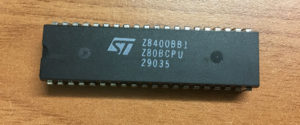The first choice I had to make has been the CPU (Central Processing Unit), the computing unit and heart of the computer. I had to choose between 3 different units: MOS 6502, Motorola 6809, and Zilog Z80, each of them are 8-bit processors that are widely available still today on the used market. I checked PROs and CONs and finally I chose the CPU that, in my humble opinion, was more suitable to my needs.
The 6502 from MOS Technology is a very famous processor, commercialized at the end of the ’70s in XX century: it has been a great hit thanks to the fact that it was very cheap when it reached the shelves (at the time it was priced $25) so it was used on a huge number of computers, including the Apple-II series and the Commodore VIC-20. Its derivatives had as much luck as it: the Atari 2600 (VCS), the Nintendo Entertainment System (NES), and the Commodore 64 are just some of the computers and game consoles built around a CPU derived by the 6502. It’s easy to write code for it, because it has a limited number of instructions, and it still has a great number of estimators that continue to use those 6502-based systems. One of the weakness of the 6502 is its lack of internal registers: in fact, it only has 3 registers, 1 accumulator and 2 index registers, not enough to write complex softwares like iterating loops around long lists of data.
The 6809 from Motorola derives by the 6800: unlike this one, it is not so famous and it has been rarely used because it wasn’t cheap. It is mainly remembered for being the processor of the TSR-80 Color Computer. Despite its internal architecture is more interesting than that of the 6502, its low prevalence at the time is reflected in the present day: in fact, there is lack of documentation and software. It’s already hard to find an assembler, much less a compiler for a different language (I would like to program in C, on my computer). Like the 6502, it doesn’t offer many registers, though it has 2 8-bits accumulators that can be joined together to be used as a single, 16-bits register.
Lastly, the Z80 from Zilog. Designed by Federico Faggin and commercialized as a cheap alternative to the 8080 from Intel, it had more luck of the latter and, together with the 6502, it dominated the 8-bits market during the first half of the ’80s: in fact, it has been used in a very huge number of home systems as the Sinclair computers (ZX80, ZX81, Spectrum) as well as the MSX computers, and in a lot of arcade systems, both as CPU and as co-processor. Its software compatibility with the 8080 has been its luck: Digital Research initially released its CP/M for this processor that it has been the most widespread operating system until the success of PCs and MS-DOS. Thanks to this compatibility, the Z80 was used as a cheap replacement of the 8080 to run the CP/M software: for example, the Commodore 128 had a Z80 inside, too. Its wide diffusion and its rich software library, as well as its internal architecture, with several 8/16-bits registers, let me chose this processor as the CPU for my computer.



